Protecting and restoring Ann Arbor's natural areas and fostering an environmental ethic among its citizens.
Volume 25, Number 3
Autumn 2020
Park Focus: Foxfire South Park
Kathleen Gosselin, Conservation Crew
As I bushwhack through a large dogwood thicket, I am immediately transported back in time when I enter Foxfire South Nature Area. I hit a small opening in the forest, and I am surrounded by Equisetum (or horsetail) species. These long, segmented plants are often referred to as “living fossils" because their subclass dates to Paleozoic forests. Large skunk cabbage leaves are mixed into the muddy groundcover and for one second, I forget I am in Ann Arbor. As I walk farther into the wetland, I can smell mountain mint in the air. My boots sink into the mud as I am surrounded by soaring Joe-pye weed and cattails that climb into the sky.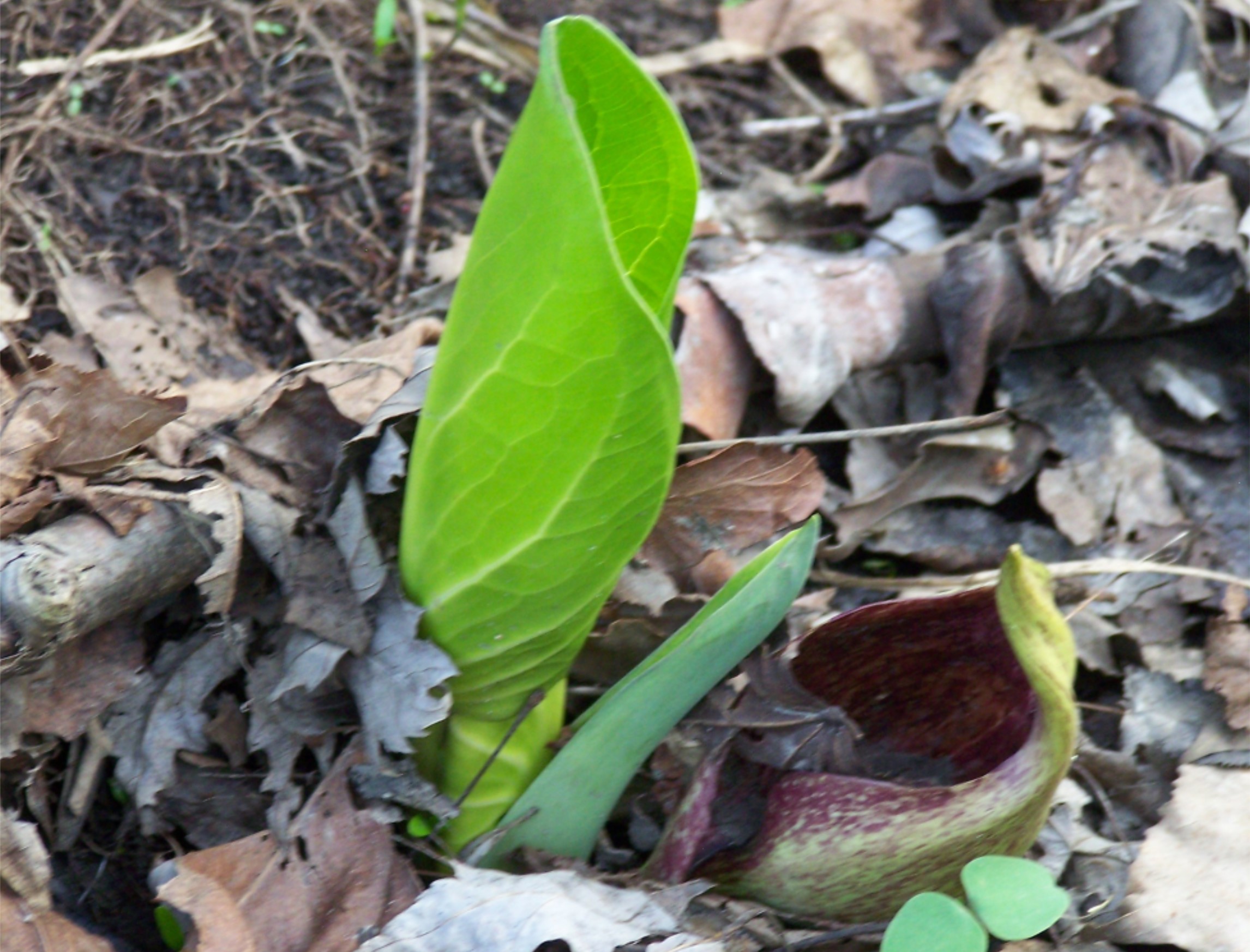
This 19-acre natural area snakes through a busy suburban neighborhood, but offers solitude of being alone in nature. These isolated pockets preserve what the area might have looked like before suburban sprawl. This is a trail-less park, which gave me the opportunity to really explore the diverse ecosystems that are represented. It's also my first time here, so I am excited to see everything Foxfire South has to offer and give a fresh perspective.
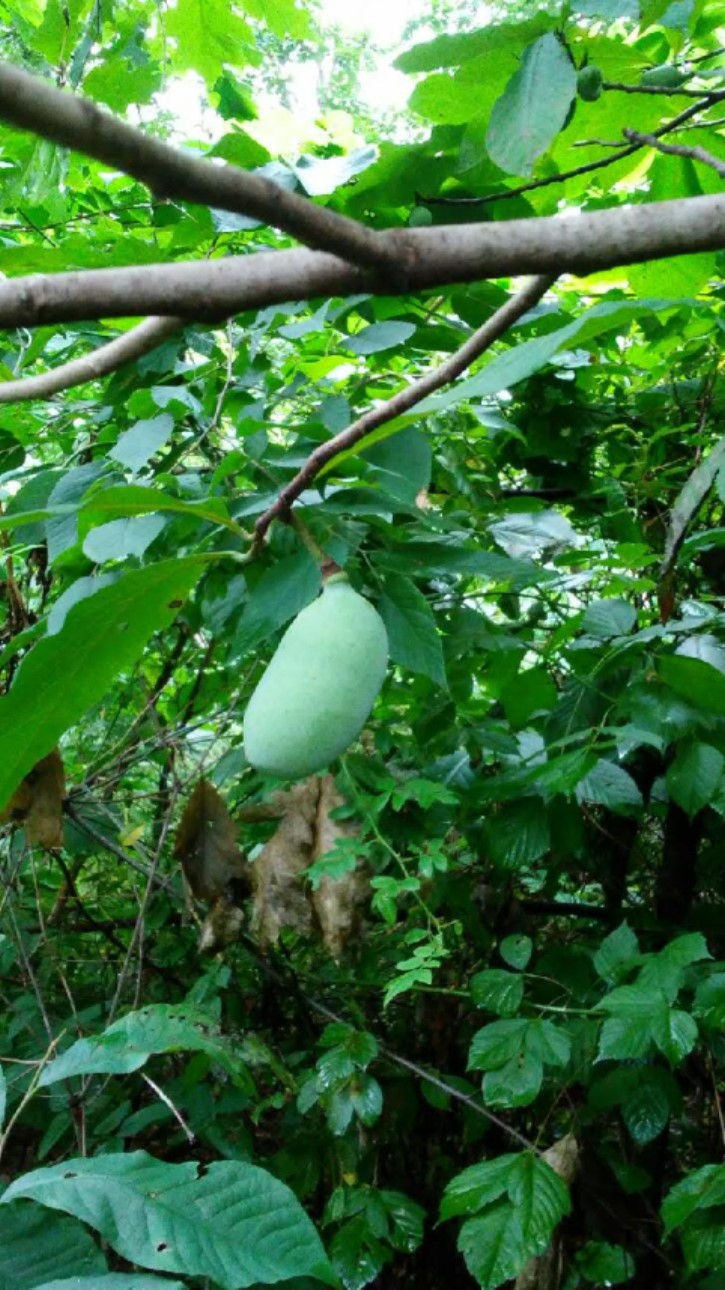 I come to the far end of the wetland and I am greeted by beautiful blue-green damselflies fluttering all around me. I notice many mature maples and various small
ash species. I was excited to see that Pawpaw trees have been sighted in this area previously, so I was eager to possibly see one. In late summer/early fall pawpaw trees bear a fruit that resembles a papaya, and I have been dying to try one. I came up to the south side of the western portion of the park and found Traver Creek twisting along the bottom of a steep slope peppered with oak saplings. I sat and watched as a Robin bathed itself in the creek, seemingly unbothered by my presence.
I come to the far end of the wetland and I am greeted by beautiful blue-green damselflies fluttering all around me. I notice many mature maples and various small
ash species. I was excited to see that Pawpaw trees have been sighted in this area previously, so I was eager to possibly see one. In late summer/early fall pawpaw trees bear a fruit that resembles a papaya, and I have been dying to try one. I came up to the south side of the western portion of the park and found Traver Creek twisting along the bottom of a steep slope peppered with oak saplings. I sat and watched as a Robin bathed itself in the creek, seemingly unbothered by my presence.
I hopped along large rocks as frogs splashed in the water and disappeared before I could get a good look at them. Past inventories indicate that amphibians and reptiles such as green frogs, garter snakes, and spring peepers have been abundant here in the past. I make my way back through the wetland north toward the edge of Dhu Varren Nature Area. After getting tangled up in Virginia creeper and mud, I succeed in finding higher ground. I am now in a late succession, or old growth, forest with a dense canopy and little groundcover. Immediately I notice the smooth bark of a large American beech tree. Many large oak trees lay on the ground after what I assume to be hundreds of years of life. The decomposing wood releases nutrients back into the forest floor.
Placid Way Park can be accessed off Omlesaad and Meadowridge and has a walking path that cuts right through the middle of Foxfire South. As I left the west side and began making my way to the east side, I spoke to a friendly neighbor who raved about collecting the many raspberries and grape leaves this area has to offer. The east side is smaller than the west side and has Traver Creek running through it as well. I noticed this side was more forested and lacked the open wetland areas. I heard a few more frogs splash into the creek as I left.
Being a nature area that is so heavily surrounded by neighborhoods and continued development, Foxfire South has its challenges. I noticed multiple piles of yard waste dumped along the perimeter of most of the park. While that doesn't seem like too big of a deal, yard waste can interfere with the natural cycle of nature areas. As a conservation worker, I am lucky enough to work towards helping Foxfire South and so many other nature areas stay “natural" as well as help educate our wonderful community on how to help. I would love to see less yard waste and more interest in using native plants while landscaping. It's a labor of love, but even the smallest effort can make a huge difference.
Also, for those wondering… I never found that pawpaw tree… but that doesn't mean you won't on your next visit to Foxfire South!
Coordinator's Corner: Changing Expectations
My younger daughter finished high school this past spring. It wasn't what she expected. No final trimester with friends; no senior prom; not even an in-person graduation. She had to settle for on-line classes and a virtual graduation. This fall, she'll be attending MSU. It turns out, this won't be what she expected either. MSU has told incoming freshmen to stay home, and all her classes will be online this semester. It's a bit of a letdown for her. Plans made, then cancelled. Schedules upended. Dreams shattered, or at least tempered, and changed.
I guess there's a lesson in there someplace, one we all learn eventually. My daughter and her classmates are learning it earlier than some. We only have so much control over what happens in our lives. Yes, it's good to plan, and to have goals and dreams. But we mustn't define the desired outcomes too narrowly or cling so tightly to our dreams that we can't recover if those dreams are shattered. Life is, after all, about change and adaptation. Those who thrive, in nature or in human society, are those who can best adapt to their ever-changing environment.
We do that as restorationists too. We write management plans for natural areas, with defined “conservation goals" – what we want a site to become. Maybe we want to restore it to native prairie, so we plant it and burn it and cut out the encroaching shrubs. But the woody competitors keep coming back, and our prairie looks more like a shrubland, or even a forest. What do we do then? Well, we have a variety of options. We could plant different prairie species that are more competitive against woody invaders. We could intensify the cutting and burning or change timing and technique. We could add grazing or mowing to our management strategies. We could alter the hydrology. Or we could change our conservation goal and decide that we want it to be more of a woodland than a prairie. The important point is that we have options, and we can choose to respond to our ever-changing environment in whatever way we choose.
Life isn't about following a carefully laid out path, at least not for most of us. It's about knowing in which direction you want to move, then picking out the best route to get there as you go, making countless adjustments along the way. My daughter will have a different college experience than she expected, but it will be a fine college experience nonetheless. Your prairie may not look like you expected it would five years after planting. There will be obstacles and unexpected challenges. But always remember that you have options, and you get to choose how to respond to those challenges. You can try new strategies, or you can change goals. You get to decide. And those decisions that you make, each one of them, the good ones and the bad ones, are what make each of our experiences unique.
-David Borneman, Natural Area Preservation Manager
Hunting for Herps with the Power of Apps
Becky Gajewski, Stewardship Specialist
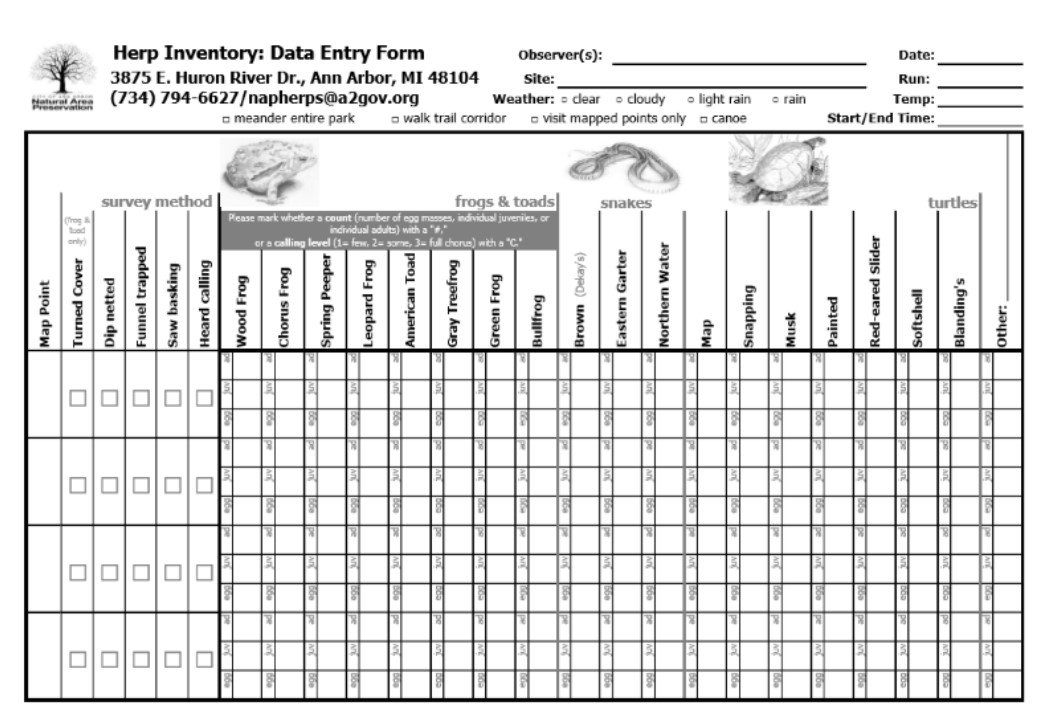 If you've ever volunteered to survey our parks for frogs and toads, salamanders, or turtles (collectively called “herps"), you've seen our survey data sheets. Scary-looking grids that take up almost an entire page, with columns, rows, and even rows within rows, to keep track of precisely how many adults, juveniles, and egg masses of each type of herp species were seen in a given survey. For years, volunteers have been toting these data sheets into the field, sometimes in the rain, and trying to record their sightings on both the sheets and on paper maps. Every new survey required a new data sheet, which had to be paired with a map, amounting to stacks of paper that had to be kept track of, and then either mailed back to us, or scanned and emailed over. There had to be a better way!
If you've ever volunteered to survey our parks for frogs and toads, salamanders, or turtles (collectively called “herps"), you've seen our survey data sheets. Scary-looking grids that take up almost an entire page, with columns, rows, and even rows within rows, to keep track of precisely how many adults, juveniles, and egg masses of each type of herp species were seen in a given survey. For years, volunteers have been toting these data sheets into the field, sometimes in the rain, and trying to record their sightings on both the sheets and on paper maps. Every new survey required a new data sheet, which had to be paired with a map, amounting to stacks of paper that had to be kept track of, and then either mailed back to us, or scanned and emailed over. There had to be a better way!
This year, we decided it was time to bring the herp survey program into the 21st century. Our other survey programs use apps like eBird (for the Breeding Bird Survey) and websites like PollardBase (for the Butterfly Survey) in order to do data collection, so why couldn't our herp surveys take advantage of mobile or web-based data entry too? Our first idea was to use an app that's already out there, like HerpMapper, or the very popular iNaturalist. We soon discovered, however, that these apps couldn't capture all of the information we normally capture during our surveys, and we also realized that it might be difficult to get our data back out of the worldwide databases behind these apps, so that we could analyze it in our mapping software.
Using a ready-made app would have been nice, but now we had to think outside the box! I had heard of an app called Survey123, which is made by Esri, the same company that makes our mapping software. The Michigan Vernal Pool Partnership had already been using this app to record information about the temporary woodland ponds where amphibians breed. If they could make a customized app for surveying vernal pools, surely we could do the same thing for surveying for herps.
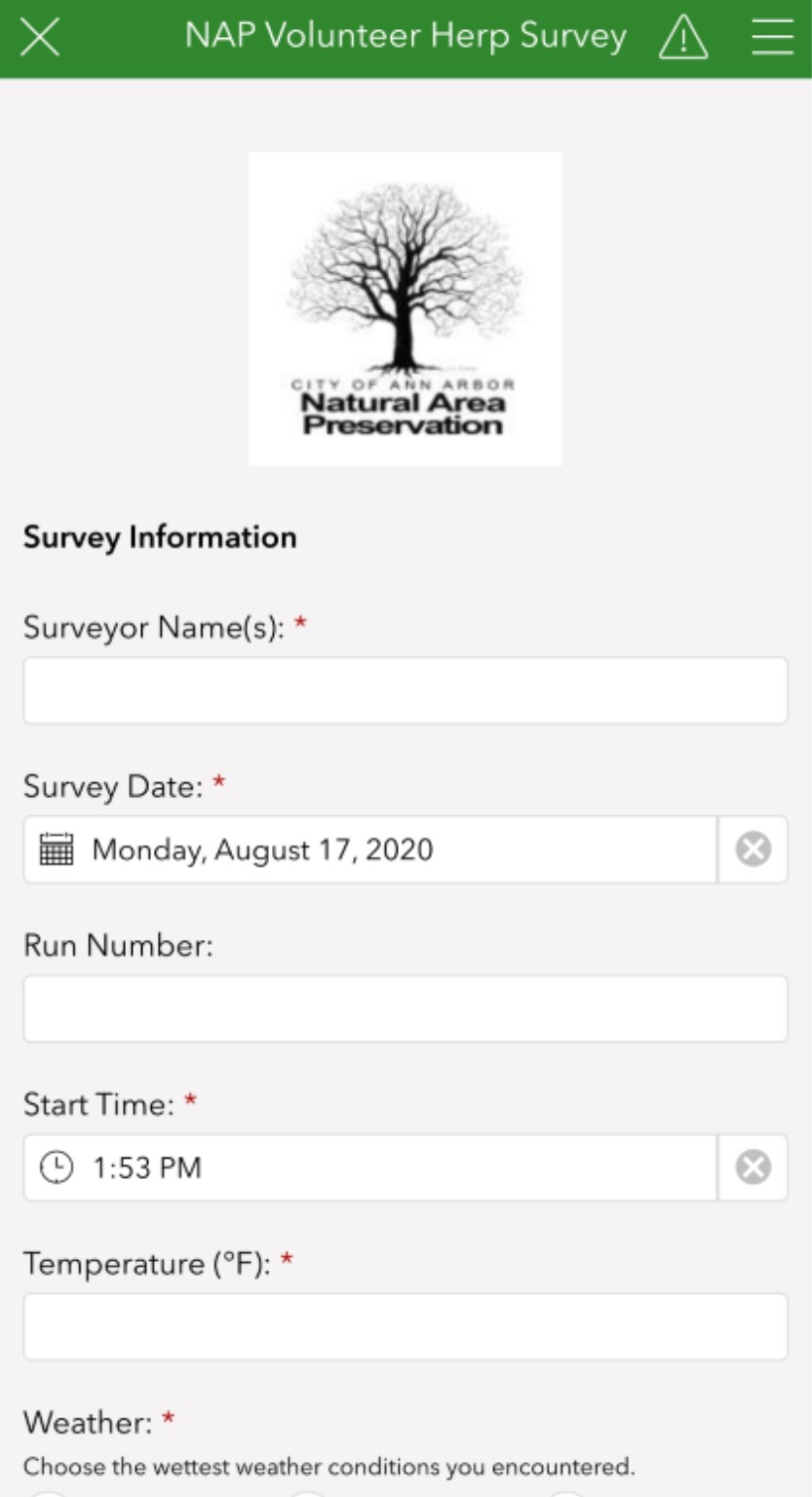 Survey123 allows you to build a “smart form" that's similar to what you might see in an online survey. Depending on what you want to know, users can type in their own information, choose from a list of choices, or pick from a dropdown menu. They can even put a pin on a map to mark a location or add a photo or an audio recording. The “smart" part of the form is that it can be customized to ask for different information depending on what users entered earlier in the form. So, if the form asks, “What kind of herp did you see?" and you choose “turtle," in the next question, “What species did you see?" you will only have turtle species to choose from. Or if you say that you heard something calling but didn't see it, your only options for species will be frogs because only frogs have calls. Pretty cool!
Survey123 allows you to build a “smart form" that's similar to what you might see in an online survey. Depending on what you want to know, users can type in their own information, choose from a list of choices, or pick from a dropdown menu. They can even put a pin on a map to mark a location or add a photo or an audio recording. The “smart" part of the form is that it can be customized to ask for different information depending on what users entered earlier in the form. So, if the form asks, “What kind of herp did you see?" and you choose “turtle," in the next question, “What species did you see?" you will only have turtle species to choose from. Or if you say that you heard something calling but didn't see it, your only options for species will be frogs because only frogs have calls. Pretty cool!
Another thing that makes Survey123 great is that it's connected directly to our mapping data. As soon as a surveyor sees a herp and enters it into the app, their location is also recorded, and a pin with all the information about what they saw is added to an online map. We can even see the information being added in real time! We can then take the data and bring it into our mapping software for analysis. As of the writing of this article, volunteers have submitted over 800 individual observations in just this first season alone! Amazing!
The Survey123 app is free to download, and data can also be entered on the web, but volunteers must get login information from us in order to be able to access the NAP Herp Survey. If you would like to get involved with our herp survey efforts, send us an email at
[email protected]!
Changes to NAP Workdays in Response to COVID-19
We are grateful for your patience as we modify our workdays in response to the COVID19 pandemic. Here are a few reminders and new guidelines for our NAP volunteer workdays. We hope to see you in the field soon!
- Pre-registration on Rec-1 is required for our workdays
- Registration closes at noon on the Friday before the workday
- The number of participants is limited. Please register early; a waitlist will become available once the event has reached capacity
- Go to www.a2gov.org/napevents and use the link provided in our Volunteer Stewardship Calendar to register
- Participants must wear a mask and maintain a 6-ft distance from others at all times
- Please wear long pants, closed-toed shoes, and leather work gloves
NAPpenings
Many thanks to the group who volunteered with NAP recently. We could not make such a difference without you!
Ann Arbor YMCA's Youth Volunteer Corps
Concordia University Ann Arbor
Staff Updates
Welcome…
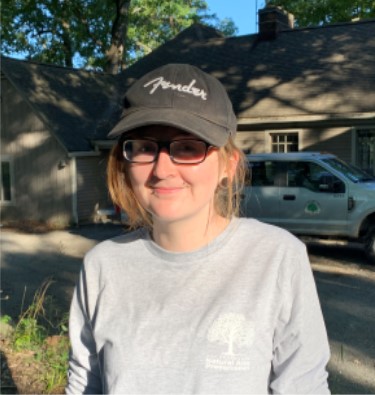 Ashley Keesling,Conservation Worker: I recently graduated with a Master's degree from Ohio State where I studied systematics and host specificity in a species of parasitic plant, Ghost pipes (Monotropa uniflora). I was also secretary of my university's chapter of the Society for Ecological Restoration where we managed a site along the Olentangy River and organized efforts to remove invasive Callery pear and Honeysuckle. In my spare time, I like to explore parks and take photos of plants, insects, mushrooms, and anything else that I find. What excites me most about working with NAP is the opportunity to learn more about methods in invasive species management and how to apply these methods to different species.
Ashley Keesling,Conservation Worker: I recently graduated with a Master's degree from Ohio State where I studied systematics and host specificity in a species of parasitic plant, Ghost pipes (Monotropa uniflora). I was also secretary of my university's chapter of the Society for Ecological Restoration where we managed a site along the Olentangy River and organized efforts to remove invasive Callery pear and Honeysuckle. In my spare time, I like to explore parks and take photos of plants, insects, mushrooms, and anything else that I find. What excites me most about working with NAP is the opportunity to learn more about methods in invasive species management and how to apply these methods to different species.
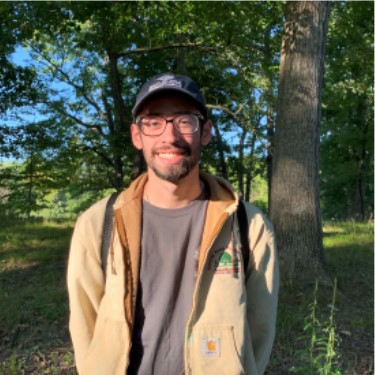 Ethan Glassman,Conservation Worker: Hi everyone, I'm really excited to be part of the NAP crew! I'm originally from Cincinnati and I went to BGSU and studied Ecology and Conservation Biology. I love spending time outside, looking for and photographing rare wildflowers. I'm new to the Ann Arbor area and I'm really excited to get to know everyone and all the natural areas!
Ethan Glassman,Conservation Worker: Hi everyone, I'm really excited to be part of the NAP crew! I'm originally from Cincinnati and I went to BGSU and studied Ecology and Conservation Biology. I love spending time outside, looking for and photographing rare wildflowers. I'm new to the Ann Arbor area and I'm really excited to get to know everyone and all the natural areas!
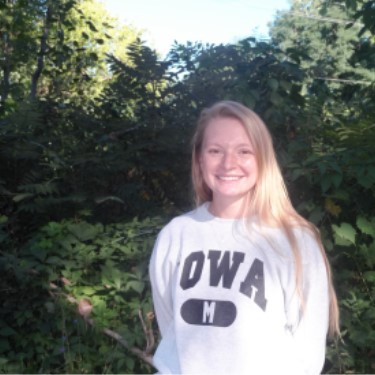 Kathleen Gosselin,Conservation Worker: I am incredibly excited to be joining the NAP team! I received my bachelor's degree in ecology from Northern Michigan University where I worked with the Marquette/Alger County conservation districts throughout my college career. After I graduated, I spent a few years in Montana working in forestry. I am excited to be back in Michigan working in the field I love. In my free time, I enjoy hiking with my two dogs and riding horses.
Kathleen Gosselin,Conservation Worker: I am incredibly excited to be joining the NAP team! I received my bachelor's degree in ecology from Northern Michigan University where I worked with the Marquette/Alger County conservation districts throughout my college career. After I graduated, I spent a few years in Montana working in forestry. I am excited to be back in Michigan working in the field I love. In my free time, I enjoy hiking with my two dogs and riding horses.
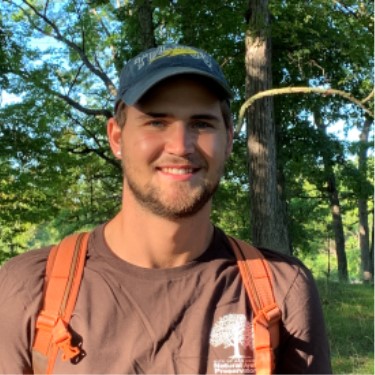 Michael (Max) Miley,Conservation Worker: I recently graduated with an Environment degree from the University of Michigan where I filled much of my course load with field classes about plants. Spending time outside and seeing the natural world change with the seasons has filled my free time since I was a kid, and I'm excited that working for NAP will let me continue those activities into my professional life. Outside of school and work, I enjoy photography, hiking, and identifying plants (usually all at once). I'm honored to be working for a local government whose residents so enthusiastically support its natural areas, and I can't wait to get out in the field!
Michael (Max) Miley,Conservation Worker: I recently graduated with an Environment degree from the University of Michigan where I filled much of my course load with field classes about plants. Spending time outside and seeing the natural world change with the seasons has filled my free time since I was a kid, and I'm excited that working for NAP will let me continue those activities into my professional life. Outside of school and work, I enjoy photography, hiking, and identifying plants (usually all at once). I'm honored to be working for a local government whose residents so enthusiastically support its natural areas, and I can't wait to get out in the field!
#NAPLOV
NAP Loves Our Volunteers!
October 2020
You're invited to celebrate your love for NAP and your fellow volunteers with us on Social Media.
- Take a selfie with your homemade #NAPLOV sign…at your favorite place to volunteer with NAP, or at your favorite Ann Arbor Nature Area.
- Post your #NAPLOV selfie to Facebook…throughout October, and tag it with #NAPLOV and @ann_arbor_NAP
- Pick up your swag…November 2-5 at the NAP office. Please let us know you're coming by sending an email to [email protected]
